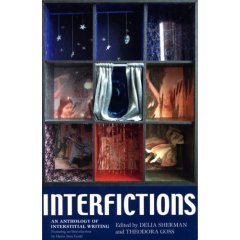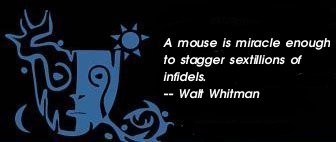|

Fantasy That Doesn't Fit
Anya Martin reviews Interfictions, a collection of stories that fall between the cracks of commercial genres and Fatal Revenant, the second volume of Stephen R. Donaldson's Third Chronicles of Thomas Covenant.
 Interfictions: An Anthology of Interstitial Writing Interfictions: An Anthology of Interstitial Writing
Edited by Delia Sherman and Theodora Goss
Interstitial Arts Foundation
I am sure the editors may wish to make a case why this anthology of "interstitial" stories shouldn't be classified as fantasy, so I want to start by saying that I have no intention of pigeonholing it as such. But because it is co-edited by Delia Sherman who is best known as a fantasy author, many members of the Interstitial Arts Foundation (IAF) come from fantasy, and most of the stories have an otherworldly element, a case can be made that it will appeal especially to those who love fantasy literature but also are frustrated by its general lack of creativity in recent years or are drawn to less-American approaches such as works of magical realism or fiction by Jonathon Carroll and Milan Kundera.
While some American authors are struggling to get their unconventional or "boundary-pushing" takes on fantasy published, up to now they usually have been rejected by editors because they do not fit into the heavily-Medieval-based epic storytelling that has grown to dominate the genre. That is, unless you are lucky enough to be Kelly Link who has been able to wedge the door open for so many other writers by getting her non-rule-abiding stories published and is wielding a refreshing influence on opening even more doorways in the field as an editor. And while science fiction and fantasy editors may not have known what to do with atypical fantasy stories, neither would so-called mainstream literary editors touch them because of that otherworldly or supernatural or quirky element they had the audacity to insert into their tale.
What is interstitial writing then? An introduction by Heinz Insu Fenkl tells us that in its Latin roots, "interstice" is a verb which means literally "to stand between" or "stand in the middle" and also as a noun refers to the space between things. So the stories in this anthology are ones that fall in between genres, which don't have to include fantasy, but seem to interstice with fantasy more often than with any other genre.
Indeed, it doesn't take long into the book before you will likely agree that you can't think of very many other anthologies that would accept these stories even though they are all very well-written and seem like no-brainers to be accepted by someone. However, it's unlikely you will know any or many of the authors' names unless you've really made an effort to look for this type of fiction. If the stories remind you of the work of any published fantasy author, it is definitely Link, particularly those that have a voice that involves the reader as a participant, something that has become a trademark of Link's style but also of a certain number of so-called mainstream "literary" authors (tracing its roots back perhaps to new journalism?) but not generally of plot-driven or character-driven fantasy. One might wonder if this type of "voice" is necessary for an interstitial story. My guess would be no, but since it's so alien to genre literature — including mystery, romance, thrillers, science fiction, too — that just happens to be where the boundary is being pushed right now. On the downside, a danger emerges that the writer will intrude too much into a story and distract the reader from the story, but in the case of Interfictions, I am happy to say that happened only a few rare times for me.
Sherman states in the "Afterword: The Spaces Between" (an interview with her and Theodora Goss) that "almost all of these stories deal in one way with process, journey, the space between life and death, certainty and uncertainty, the time-bound and the eternal." So the stories themselves are not only problematic to classify within established genres, but also often deal thematically with an in-between state, or what Fenkl calls "liminality." Now that's a word which excites those of us who are excited by explorations of narratives in postmodern anthropology — I don't have time to go into that here, but trust me, it's fun stuff. OK, to you, it doesn't sound fun, but just read the discussions of cyclical and linear time in Marshall Sahlins' Islands of History and see if it doesn't excite your brain in an interstitial kind of way.
Back to Interfictions, I tried to read all 19 stories during several very intense reading sessions, but found myself inclined to take breaks between the stories. That to me was a sign that the stories insisted on being digested and savored rather than devoured. One of the greatest pleasures was not knowing where each story was going when I started it. In all cases, I was surprised and often more so amazed and delighted by that surprise — i.e. unlike much conventional genre literature or movies or TV, I didn't see it coming from the beginning or even halfway through. The great thing about the stories in Interfictions is not just that they don't fit into the conventional borders, that they push those limits, but each story left me contemplative. It made me think about a variety of heady subjects ranging from the sublime to the disturbing.
There were a few stories that I didn't immediately get into, but only one had an ending that did not redeem it. In general, getting to the end just made me want to go back to the beginning and give those stories another chance.
I don't want to ruin those surprises for you either. So if you've read enough to whet your appetite, just get the book and read no further. If you need a little more, I'm going to break with the rules of traditional reviewing and say something about some of the stories which were my personal favorites. However, I'm not going to mention the titles so you won't know which story I'm talking about until you get into it and I'm never going to reveal the endings. And just to mix it up even more, I'm not going to talk about the stories in the order that they appear in the book either.
One story that hit me hard deals with our powerlessness over that moment before an accident happens when if you did something else, just even slightly different, the accident wouldn't have happened and contrasts those times with the moment before the protagonist finds out something she has no control over — whether her mother has cancer. This troubling conversation is one that everyone has with ourselves (is it a requirement of being human?), and the way the author tackled it head on left me with a palpable sense of anxiety.
One author tells a ghost story from the point of view of the entire town. The tale perhaps most evocative of magic realism concerns a deal between two brothers that involves a dead cow, a bunch of ultra-devout nuns and a sorcerer in an extraordinary village where God is everywhere. Another story takes off from the premise that an account of a magical land discovered by a Medieval priest was truly real but plays it from the point of view of the denizens, not the priest. Then there's the girl that mails herself to the boyfriend who spurned her, but no realism here — she doesn't suffer the fate in that post-punk song by The Fall —instead she takes up residence in the post office and nobody thinks it's odd.
Two stories are retellings of fairy tales, but as the editors explain in their afterword, while fairy tale retellings have become a genre unto its own, these stories stood out by being distinctly different from the vast majority of re-imaginings. One plays lyrically on that fairy tale of seven ravens as seven brothers but is reset on the upper end of New York City with a lonely young woman as its protagonist. The other — one of my very favorites in the book — reveals itself early on to be a take on "Sleeping Beauty," but after a while the reader recognizes the cursed princess to be someone famous and totally unlikely, and I'd better stop there in case I haven't already given too much away. And I agree with the editors that another story has a fairy tale feel — the one where the woman calls for the cat and instead a cat-like man comes, insisting he is her cat transformed.
The anthology even tackles Biblical territory in an innovative story where Joseph, the seer of dreams, old and dying in Egypt, has a premonition of Moses that makes him distinctly uncomfortable. A lake literally comes to life to save a man from suicide, then continues to talk to him and even visits his apartment. A writer who is a stranger in a foreign land desperately awaits an answer that keeps her creative life in stasis. Two brothers carry their father's body up a mountain so that God will forgive his many sins.
Is that enough of a tease to your palate? Go ahead then. What are you waiting for? Buy this book so that the Foundation, which also supports interstitial efforts in other arts, will have the money to publish more like it.
Read a short story from Interfictions
Return to Passages Menu
Subscribe to the Passages e-zine
|

